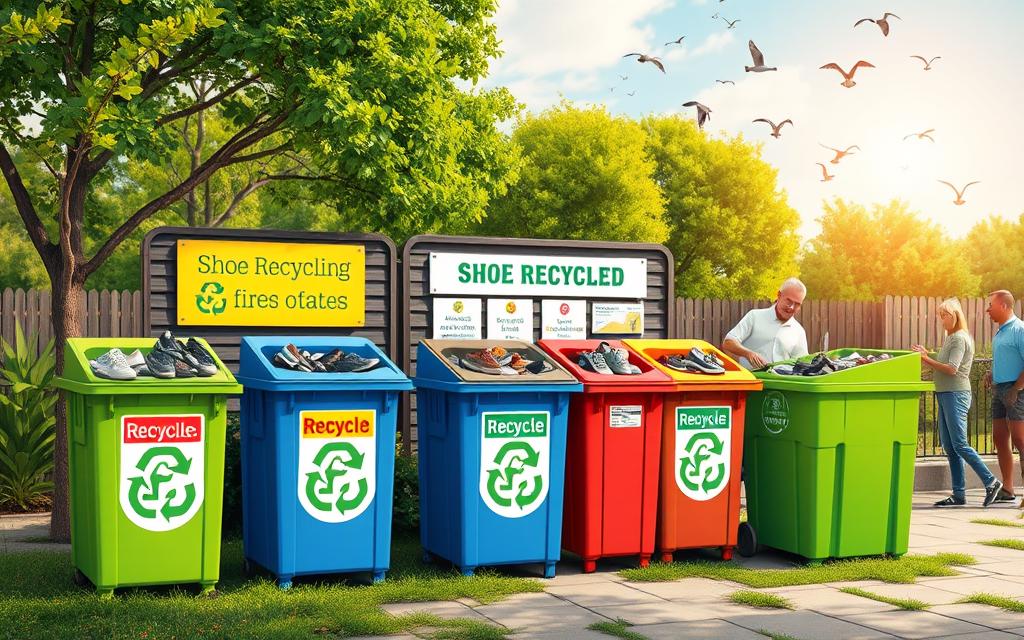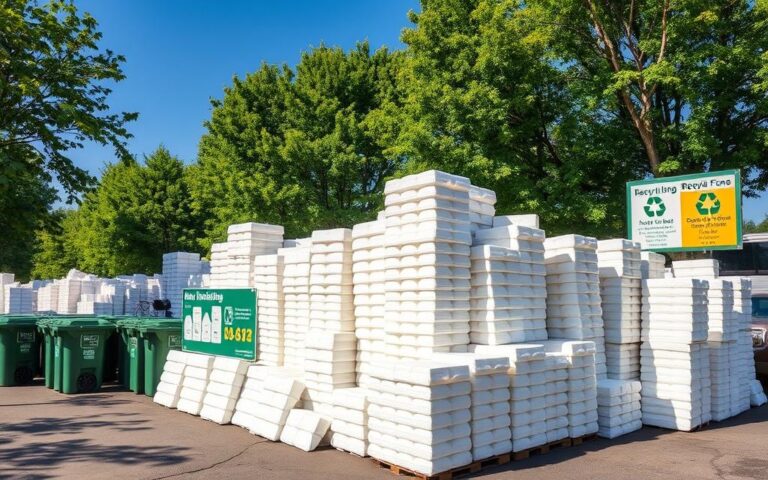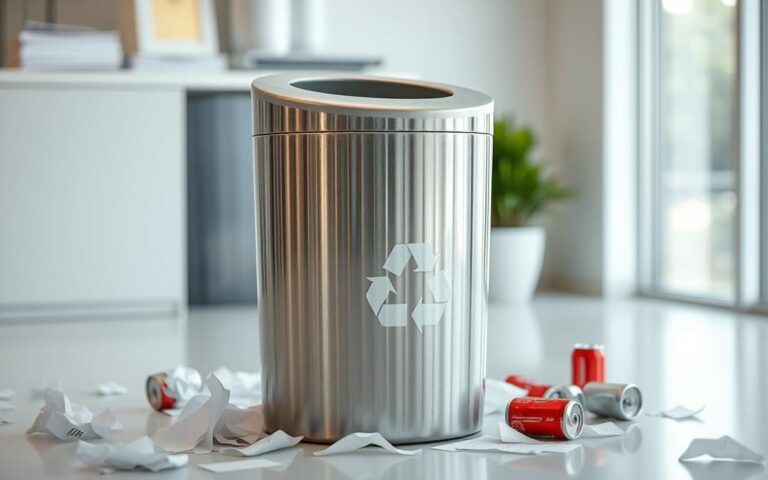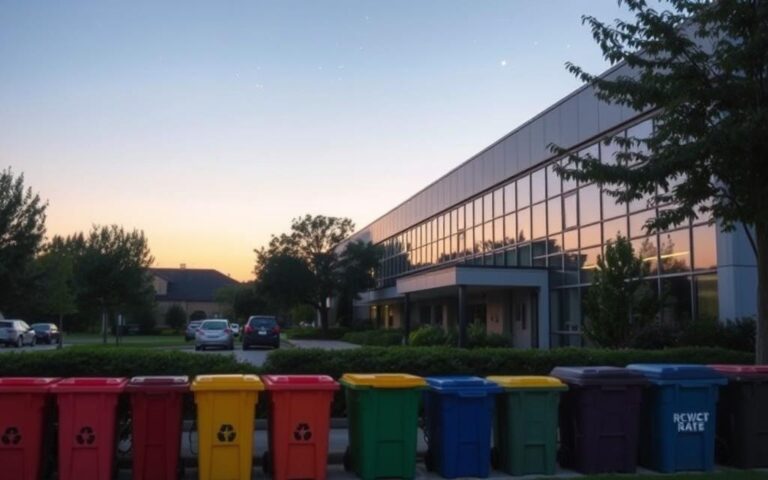Where Can I Recycle Shoes? Sustainable Options
Recycling shoes is vital for our environment. In 2019, the world made an incredible 24.3 billion pairs of shoes. Sadly, most of these shoes end up in landfills. This is a problem because shoes can take many years to break down. They also release harmful chemicals into our earth.
Every year, we throw away about 12.8 million tons of shoes. This shows how important it is to find eco-friendly ways to dispose of shoes. By recycling or donating your shoes, you give them a new life. This helps lower the need for making more shoes, which often uses a lot of carbon. Let’s work together for a greener future.
Understanding the Importance of Shoe Recycling
Shoe recycling is key to reducing landfill waste since a lot of footwear is thrown away yearly. In the U.S., over 300 million pairs of shoes are tossed out annually. This creates a big environmental issue. Shoes are made from rubber, plastic, and leather, which take ages to decompose. They add to pollution and waste. By recycling shoes, we can ensure these materials get a new life instead of harming the planet.
Environmental Impact of Disposing Shoes in Landfills
Throwing shoes in landfills does more harm than just creating piles of waste. A single pair of sneakers can produce 30 pounds of CO2 emissions. This adds to greenhouse gases. It can take up to 40 years for shoes to decompose, releasing harmful chemicals. The global footwear industry is responsible for about 1.4% of all greenhouse gas emissions. If we choose eco-friendly disposal, like recycling, we can lessen this impact significantly.
The Lifespan of Shoes and Their Decomposition
The breakdown of shoes is not straightforward due to their materials. Shoes contain parts that don’t easily break down. This includes rubber, plastics, and leather. These can stay in the environment for a long time. But many recycling programs now turn these materials into new items. This helps the environment. Raising awareness about shoe recycling can lead to more people disposing of shoes responsibly.
Where Can I Recycle Shoes?
Recycling shoes helps our planet and reduces the huge amount of shoe waste we create every year. With the world making billions of shoes, we really need good ways to recycle them. Knowing where to recycle can make a big difference in keeping shoes out of landfills.
Overview of Shoe Recycling Programs Available
There are many programmes for recycling different types of shoes, including:
- Nike’s Reuse-A-Shoe Program: This takes old athletic shoes to make new products. But, it won’t take sandals or dress shoes.
- TerraCycle: They recycle lots of shoe types if they meet certain rules.
- American Textile Recycling Service: They have bins where you can drop shoes and clothes that you don’t want anymore.
Knowing about these programmes can help you find where to recycle shoes. It encourages us all to throw away less.
Material Breakdown and Their Recycling Processes
The materials in your shoes decide how they are recycled. The main materials that get recycled are:
| Material Type | Recycling Process | Potential Uses |
|---|---|---|
| Rubber | Shredded and processed | Playground surfaces, flooring, and sports tracks |
| Textiles | Separated and cleaned | Insulation materials, new fabric products |
| Leather | Processed for reuse | New leather goods, accessories |
When you know about the recycling material types, you can help more. Plus, you keep rubbish out of our landfills.
Donation Options for Gently Used Shoes
Donating shoes helps those in need and supports sustainability. Many charity organisations accept gently used shoes. They ensure these shoes get a second chance at use, rather than being thrown away. This is crucial for community help and caring for our planet.
Charity Organisations Actively Accepting Shoe Donations
Many well-known groups take in shoe donations, supporting various good causes:
- Soles4Souls: Since 2004, they’ve given out over 53 million pairs of shoes worldwide. They aid those in need and encourage sustainable business.
- Goodwill: Known for collecting various items, including shoes. They use sales profits to run community programs.
- Share Your Soles: This Chicago-based charity provides shoes to those in poverty or without homes, doing so with respect.
The Benefits of Donating Shoes
The good from donating shoes spreads far and wide. By giving shoes away, you can:
- Support Local Communities: It helps give shoes to those who can’t afford them, covering a basic life need.
- Reduce Environmental Impact: Donating shoes cuts down on waste, as shoes take decades to break down.
- Encourage Charity Recycling: Groups like GotSneakers and American Textile Recycling Service offer easy ways to give shoes a new life.
In summary, giving shoes away does good for both people and the planet. This action supports needy individuals and promotes green practices.
Specialised Companies for Shoe Recycling
As people realise the impact of throwing away shoes, some companies are stepping up. Terracycle and Nike Grind are leading the way in shoe recycling. Together, they show that the shoe industry can work towards being more sustainable.
Terracycle: An Extensive Recycling Programme
Terracycle offers a wide recycling service for all kinds of shoes. Through its zero-waste programme, it invites customers to send in shoes for recycling. Some services might cost a bit, but Terracycle’s aim is to cut down waste. It turns old shoes into new products, promoting a cycle of sustainability.
Nike Grind: A Sustainable Initiative from a Leading Brand
Nike Grind focuses on recycling athletic shoes. It turns them into things like playgrounds and new shoes. Customers can bring their old running shoes to any Nike store. This effort helps reduce the waste from sports shoes. Nike Grind shows how big brands can help make a difference in environmental sustainability.
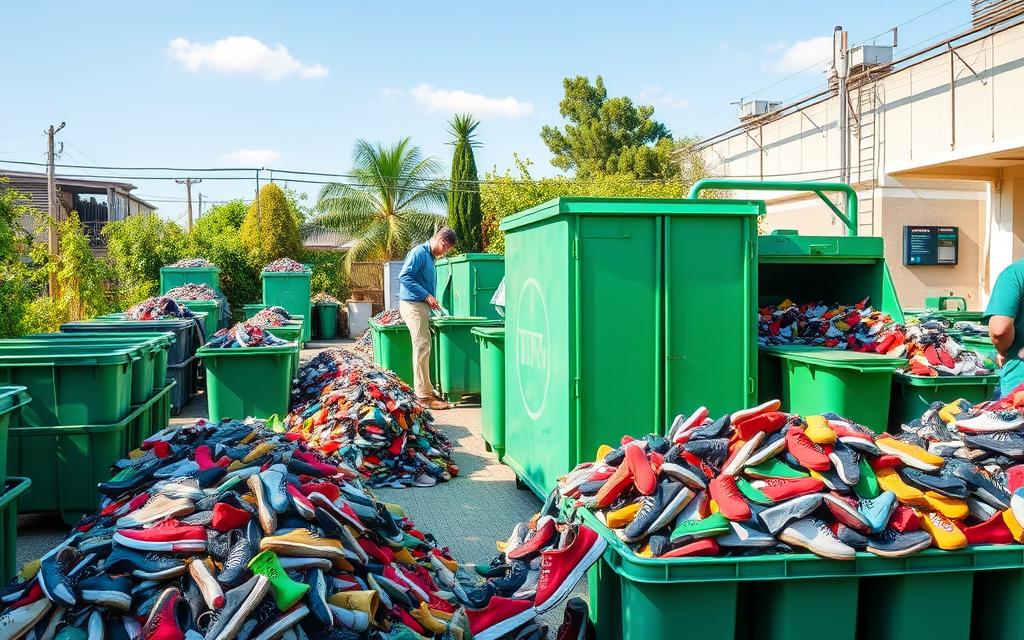
Local Recycling Centres and Drop-off Points
Finding local centres to recycle shoes is key to eco-friendly disposal. Communities have specific spots where you can take your unwanted shoes. This helps our planet and supports efforts to cut down on trash.
How to Find Suitable Recycling Centres in Your Area
To find nearby recycling centres, check out local government sites or notice boards. They list where you can bring your shoes. Retailers and charities may also have recycling schemes. They offer easy places to leave your shoes. For more help, check this guide for places to donate or recycle shoes.
Understanding the Guidelines for Shoe Recycling
It’s important to know the rules before you recycle shoes. Centres might ask for shoes to be clean or accept only certain types. Knowing this makes recycling smooth and helps manage waste better.
Recycling shoes cuts down on a lot of waste. Every year, clothes and shoes make up 85% of landfill waste. That’s 17 billion pounds of items we could reuse or recycle. Choosing wisely makes a big difference to our environment.
Alternative Uses: Upcycling Shoes
Upcycling shoes gives new purpose to old footwear, making it a fun task. This activity turns old shoes into useful or decorative items. It promotes being eco-friendly. Each year, millions of shoes are thrown away. Doing DIY shoe projects can be enjoyable and rewarding.
Creative Ways to Repurpose Old Shoes
There are many creative ideas for giving old shoes a new lease on life. Some top ways to repurpose shoes include:
- Turning shoes into planters for colourful plants inside or outside.
- Making pin cushions from shoes, a great idea for those who sew.
- Creating a birdhouse that makes nature watchers happy.
- Attaching hooks to shoes to make unique coat racks.
- Using shoes as canvases for painting, creating beautiful art.
DIY Upcycling Ideas for Your Footwear
The DIY community loves coming up with new uses for old shoes, offering many project ideas. On sites like Pinterest, you can find:
- Building your own shoe racks from old shoes.
- Turning classic shoes into stylish vintage home decor.
- Changing worn trainers into dog toys.
- Making accessory holders for jewellery or trinkets.
https://www.youtube.com/watch?v=6YQlIFO0wYw
In today’s eco-conscious world, creative shoe repurposing helps reduce waste. Working on DIY shoe projects boosts your creativity and helps the planet too.
Eco-Friendly Practices When Disposing of Shoes
It’s crucial to dispose of shoes in an eco-friendly way to lessen environmental damage. Millions of shoes end up in landfills every year. Knowing how to properly dispose or recycle them can help our planet. Let’s look at how to get shoes ready for recycling.
Best Practices for Preparing Shoes for Recycling
For shoes to be recycled properly, follow these steps:
- Clean the Shoes: Get rid of dirt to prevent contamination in the recycling process.
- Remove Non-Recyclable Parts: Take away laces, buckles, and insoles that can’t be recycled.
- Check Material Composition: Understanding your shoes’ materials helps find the right recycling option.
- Assess Condition: If they’re still in good shape, consider donating them instead.
What to Consider Before Throwing Shoes Away
Think about these points to practice sustainable shoe disposal:
- Recycling Programmes: Look for local programmes accepting shoes. Soles4Souls teams up with stores for drop-off points.
- Brand Initiatives: Companies like Brooks and Nike offer recycling initiatives for responsible disposal.
- Environmental Impact: Learn about the harm that comes from wrongly discarded shoes, like chemical pollution and landfill issues.
By adopting these eco-friendly habits for shoe disposal, we help build a circular economy. It also reduces our carbon footprint. Taking small steps such as preparing shoes for recycling can have a big impact on waste management.
Conclusion
The world makes over 20 billion shoes every year. This makes shoe recycling super important. The shoe industry might grow to more than $95 billion by 2025. This means we really need sustainable shoe options. By recycling, donating, and upcycling shoes, we make a big difference. This helps lower our carbon footprint and supports a green economy.
Using cool tech like shredding helps a lot with recycling shoes. It makes it easier to take shoes apart and reuse materials like rubber and textiles. This way, we can make new, eco-friendly products. Athletic shoes, for example, are easy to recycle. So, we all can do our part to help the planet.
It’s important to recycle or donate old shoes. This reduces the huge problem of shoe waste. When we understand how good recycling shoes is, we can work together. We can make our communities and the environment better for everyone in the future.
FAQ
Why is shoe recycling important for the environment?
Recycling shoes helps cut down the waste that ends up in landfills. Landfills can take 40 years to break down shoes. Recycling reduces harmful chemicals in the soil and lessens the need for new shoes. This cuts down carbon emissions too.
What types of shoes can be recycled?
Recycling programmes accept different types of shoes. For example, Nike Grind takes athletic shoes. Teracycle accepts various footwear, including sandals and dress shoes, if they meet the conditions. Always check a programme’s guidelines before donating.
What are the benefits of donating gently used shoes?
Donating shoes helps communities in need and promotes sustainability. It gives shoes another life. Organisations like Soles4Souls and Goodwill send shoes worldwide. This helps raise economies and creates jobs in shoe refurbishment.
How can I find local shoe recycling centres?
Look online for shoe recycling centres near you. Many places like retail stores offer recycling services. Knowing your local recycling rules is helpful for proper shoe disposal.
What practices should I follow to prepare shoes for recycling?
Clean the shoes and remove any parts that can’t be recycled, like laces and buckles. Know what your recycling programme takes to be more effective. Also, think about if the shoes could be fixed or donated to reduce waste.
What is upcycling, and how can I repurpose old shoes?
Upcycling is when you turn old shoes into something new. You can make things like planters or art from old shoes. Look at Pinterest for DIY upcycling ideas. It’s a great way to reduce waste and be creative.

